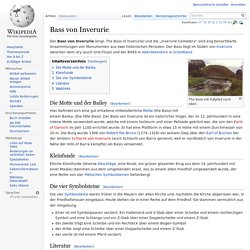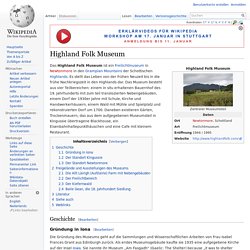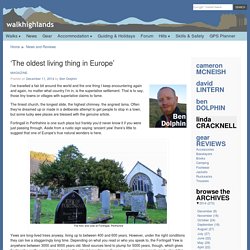

Maiden Stone. Coordinates: East face of Maiden Stone The Maiden Stone, also known as the Drumdurno Stone after the nearby farm, is a Pictish standing stone near Inverurie in Aberdeenshire in Scotland, probably dating to the 9th century AD.

Name[edit] The name is derived from local legend, incorporating the most obvious mark of wear and tear on the stone: a triangular notch toward the top of the monument. Based on the mixture of Pictish and Christian symbols on the stone it is most likely that the stone marks a preaching site during missionary trips to the Picts. Description[edit] The stone is red granite, standing 3.01m high (one of the tallest of all Pictish monuments, even though several centimetres have been lost at the top owing to weathering).
The west side has a ringed cross below a human figure between two "fish-monsters". Bass von Inverurie. Der Bass von Inverurie (engl.

The Bass of Inverurie) und die „Inverurie Cemetery“ sind eng benachbarte Ansammlungen von Monumenten aus zwei historischen Perioden. Der Bass liegt im Süden von Inverurie zwischen dem Ury (auch Urie-Fluss) und der B993 in Aberdeenshire in Schottland. The Bass mit Fußpfad nach oben Die Motte und der Bailey[Bearbeiten] Kleinfunde[Bearbeiten] Die vier Symbolsteine[Bearbeiten] Die vier Symbolsteine waren früher in die Mauern der alten Kirche und, nachdem die Kirche abgerissen war, in der Friedhofsmauer eingebaut.
Inverurie 1 Class I Pictish Symbol Stone. Inverurie Kirkyard Pictish Symbol Stone. Four early Pictish stones.

The tall pillar bears incised symbols of a crescent and V-rod, disc and rectangle serpent and Z-rod and double disc and Z-rod. Pictish Symbol Stones. Aberdeenshire formed one of the heartlands of the northern Picts between the fourth and ninth centuries AD.

View site locations The Picts are known chiefly for their elaborately but regularly decorated memorial stones found in profusion throughout eastern Scotland from Shetland to the Firth of Forth. However, much more is actually known about them than that. Society Militaristic and aristocratic, their society had several grades, including cavalry and footmen, a peasantry, part of whom was bonded to the land, all ruled by tribal chiefs and kings. Symbol Stones The symbol stones are decorated in a structured way with a series of animal and object symbols current in late Roman Iron Age times (third/fourth centuries AD) - mirrors, combs, cauldrons, geese, hounds, etc. 5th - 7th Century. Dunnet Bay - North Scotland campsite - Cool Camping.
Just back from a trip up north & we stayed one night here.

They only have two pitches set aside for tents but if there is space and there are no more vans booked in they will take more tents.Arrive before 20:00 if you want to get in, after that the gates are shut and the warden has an eve off.£17 for one night for two of us a car and a tiny tent felt a bit steep, but they do have great facilities and the pitches were big and flat. Try and get one away from a hook up point as they have a bright light on top of them and shine in the tent all night like a search light, we ended up fastening a bin liner round it!
There are rules about rules on this site, how you pitch, where you put your car, no cycling, vacating the toilet block 5 minutes before scheduled cleaning time and when I was getting showered, a lady (not official) telling us how to rotate through the showers correctly to ensure efficient "throughput"! Definitely not an open fires kind of site! Stroma View Campsite. Highland Folk Museum. Das Highland Folk Museum ist ein Freilichtmuseum in Newtonmore in den Grampian Mountains der Schottischen Highlands.

Es stellt das Leben von der frühen Neuzeit bis in die frühe Nachkriegszeit in den Highlands dar. Das Museum besteht aus vier Teilbereichen: einem in situ erhaltenen Bauernhof des 19. Jahrhunderts mit zum teil translozierten Nebengebäuden, einem Dorf der 1930er Jahre mit Schule, Kirche und Handwerkerhäusern, einem Wald mit Mühle und Spielplatz und rekonstruierten Dorf um 1700. Daneben existieren Gärten, Trockenmauern, das aus dem aufgegebenen Museumsteil in Kingussie übertragene Blackhouse, ein Eisenbahnhaltepunkthäuschen und eine Cafe mit kleinem Restaurant.
Geschichte[Bearbeiten] Gründung in Iona[Bearbeiten] Die Gründung des Museums geht auf die Sammlungen und Wissenschaftlichen Arbeiten von Frau Isabel Frances Grant aus Edinburgh zurück. Champion Trees of the UK. ‘The oldest living thing in Europe’ I’ve travelled a fair bit around the world and the one thing I keep encountering again and again, no matter what country I’m in, is the superlative settlement.

That is to say, those tiny towns or villages with superlative claims to fame. The tiniest church, the longest slide, the highest chimney, the angriest lama. Often they’re dreamed up or made in a deliberate attempt to get people to stop in a town, but some lucky wee places are blessed with the genuine article. Fortingall in Perthshire is one such place but frankly you’d never know it if you were just passing through. Aside from a rustic sign saying ‘ancient yew’ there’s little to suggest that one of Europe’s true natural wonders is here. The Kirk and yew at Fortingall, Perthshire Yews are long-lived trees anyway, living up to between 400 and 600 years.
Which came first? Like many of the ancient yews across Great Britain, the Fortingall yew is located in a churchyard. My visit Walking in the footsteps of history. Www.visitjohnogroats.com. John O'Groats Caravan and Camping site.